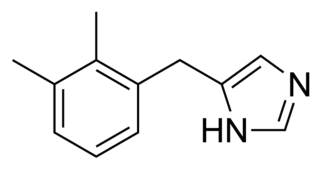
Ketoprofen is one of the propionic acid class of nonsteroidal anti-inflammatory drugs (NSAID) with analgesic and antipyretic effects. It acts by inhibiting the body's production of prostaglandin.

Phenylbutazone, often referred to as "bute", is a nonsteroidal anti-inflammatory drug (NSAID) for the short-term treatment of pain and fever in animals.

Laminitis is a disease that affects the feet of ungulates and is found mostly in horses and cattle. Clinical signs include foot tenderness progressing to inability to walk, increased digital pulses, and increased temperature in the hooves. Severe cases with outwardly visible clinical signs are known by the colloquial term founder, and progression of the disease will lead to perforation of the coffin bone through the sole of the hoof or being unable to stand up, requiring euthanasia.

Meloxicam, sold under the brand name Mobic among others, is a nonsteroidal anti-inflammatory medication (NSAID) used to treat pain and inflammation in rheumatic diseases and osteoarthritis. It is used by mouth or by injection into a vein. It is recommended that it be used for as short a period as possible and at a low dose.

Carprofen is a nonsteroidal anti-inflammatory drug (NSAID) of the carbazole and propionic acid class that was previously for use in humans and animals but is now only available to veterinarians for prescribing as a supportive treatment for various conditions in animals. Carprofen reduces inflammation by inhibition of COX-1 and COX-2; its specificity for COX-2 varies from species to species. Marketed under many brand names worldwide, carprofen is used as a treatment for inflammation and pain, including joint pain and postoperative pain.

Oxyphenbutazone is a nonsteroidal anti-inflammatory drug (NSAID). It is a metabolite of phenylbutazone.
Exercise-induced pulmonary hemorrhage (EIPH), also known as "bleeding" or a "bleeding attack", refers to the presence of blood in the airways of the lung in association with exercise. EIPH is common in horses undertaking intense exercise, but it has also been reported in human athletes, racing camels and racing greyhounds. Horses that experience EIPH may also be referred to as "bleeders" or as having "broken a blood vessel". In the majority of cases, EIPH is not apparent unless an endoscopic examination of the airways is performed following exercise. This is distinguished from other forms of bleeding from the nostrils, called epistaxis.

Tepoxalin, sold under the brand name Zubrin among others, is a non-steroidal anti-flammatory drug (NSAIDs) generally used in veterinary medicine to reduce swelling in animals with osteoarthritis. In rare circumstances, tepoxalin can also be used in human pharmacology to relieve pain caused by musculoskeletal conditions such as arthritis and hip dysplasia.

Detomidine is an imidazole derivative and α2-adrenergic agonist, used as a large animal sedative, primarily used in horses. It is usually available as the salt detomidine hydrochloride. It is a prescription medication available to veterinarians sold under various trade names.

Tiludronic acid is a bisphosphonate used for treatment of Paget's disease of bone in human being medicine. It has the tradename Skelid. In veterinary medicine, tiludronic acid is used to treat navicular disease and bone spavin in horses. Its tradenames are Tildren and Equidronate. It is approved for treatment of navicular disease and distal, tarsal osteoarthritis in Europe, and was approved for treatment of navicular disease in the United States in 2014.

Meclofenamic acid is a drug used for joint, muscular pain, arthritis and dysmenorrhea. It is a member of the anthranilic acid derivatives class of nonsteroidal anti-inflammatory drugs (NSAIDs) and was approved by the US FDA in 1980. Like other members of the class, it is a cyclooxygenase (COX) inhibitor, preventing the formation of prostaglandins.
Limb perfusion is a medical technique that is used to deliver drugs locally directly to a site of interest. It is commonly used in human medicine for administration of anticancer drugs directly to an arm or leg. It is also used in veterinary medicine to deliver drugs to a site of infection or injury, as well as for the treatment of cancer in dogs. In both cases, a tourniquet is used to reduce blood flow out of the area that is being treated.

Romifidine is a drug that is used in veterinary medicine as a sedative mainly in large animals such as horses, although it may be used in a wide variety of species. It is not used in humans, but is closely related in structure to the commonly used drug clonidine.
Colitis X, equine colitis X or peracute toxemic colitis is a catchall term for various fatal forms of acute or peracute colitis found in horses, but particularly a fulminant colitis where clinical signs include sudden onset of severe diarrhea, abdominal pain, shock, and dehydration. Death is common, with 90% to 100% mortality, usually in less than 24 hours. The causative factor may be Clostridium difficile, but it also may be caused by other intestinal pathogens. Horses under stress appear to be more susceptible to developing colitis X, and like the condition pseudomembranous colitis in humans, an association with prior antibiotic use also exists. Immediate and aggressive treatment can sometimes save the horse, but even in such cases, 75% mortality is considered a best-case scenario.
Purpura haemorrhagica is a rare complication of equine strangles and is caused by bleeding from capillaries which results in red spots on the skin and mucous membranes together with oedema (swelling) of the limbs and the head. Purpura hemorrhagica is more common in younger animals.
Equine gastric ulcer syndrome (EGUS) is a common cause of colic and decreased performance in horses. Horses form ulcers in the mucosa of the stomach, leading to pain, decreased appetite, weight loss, and behavioral changes. Treatment generally involves reducing acid production of the stomach and dietary management. Unlike some animals, however, stomach rupture is rare, and the main goal of treating is to reduce pain and improve performance of animals used for showing or racing.
The treatment of equine lameness is a complex subject. Lameness in horses has a variety of causes, and treatment must be tailored to the type and degree of injury, as well as the financial capabilities of the owner. Treatment may be applied locally, systemically, or intralesionally, and the strategy for treatment may change as healing progresses. The end goal is to reduce the pain and inflammation associated with injury, to encourage the injured tissue to heal with normal structure and function, and to ultimately return the horse to the highest level of performance possible following recovery.

Balanced anesthesia is an anesthetic method for surgical patients during their operation, which was proposed by John Lundy in 1926. The purpose of balanced anesthesia is not only to be less dangerous than using only one drug to make patients general anesthesia but also to minimise the potential adverse side effects which may cause by the anesthetic agents. The concept of balanced anesthesia is that applying two or more medications or techniques in order to help patients to ease pain, relax the muscles and have autonomous reflection suppression. In other words, it is an anesthesia method to maintain stable vital signs. There are numerous factors that come in play when the anesthetist decides to use this method of anesthesia. These factors include, but are not limited to, patients' major organ functions, general condition and compensatory capacity. The anesthetist needs to make use of adequate types, appropriate amounts of agents and the accurate anesthesia method, which will promote the surgery to be successful, safe, and efficient.
Alicia L. Bertone is an American academic, administrator, researcher, and veterinary surgeon. She is a professor and a provost in the Office of Academic Affairs at the Ohio State University. Bertone has worked as the Vice-Provost of Graduate Studies, Associate Vice Provost of Data and Analysis, the ENGIE-Axium Endowed Dean of the Graduate School, and the Trueman Family Endowed Chair at the Ohio State University. Bertone is a Professor of Veterinary Clinical Sciences, and, as the Trueman Endowed Chair, established and directed the Comparative Orthopedic Research Laboratory at the University.












